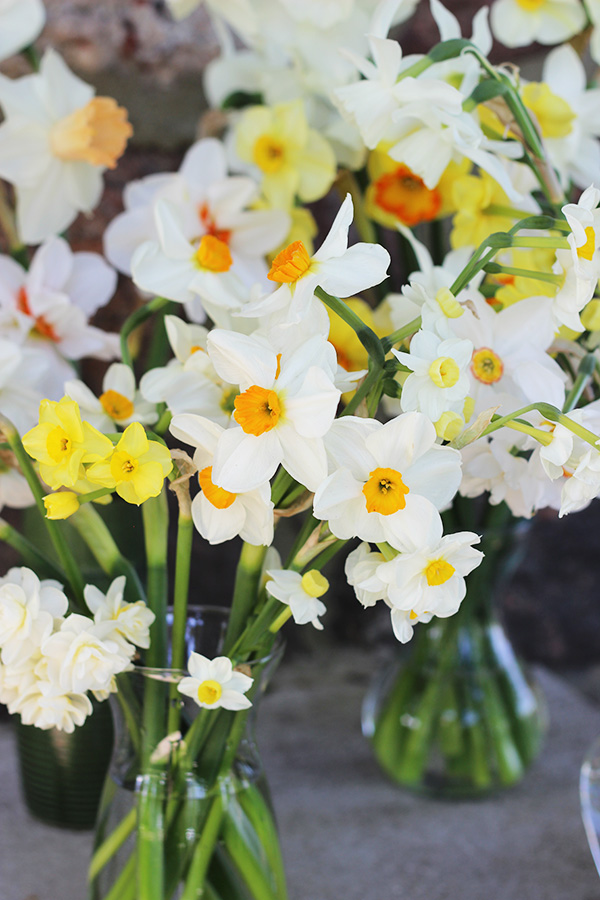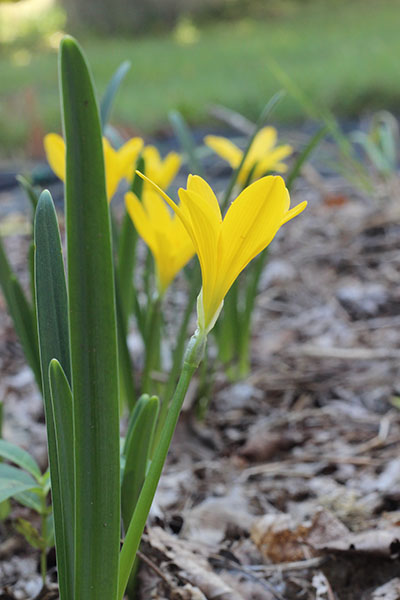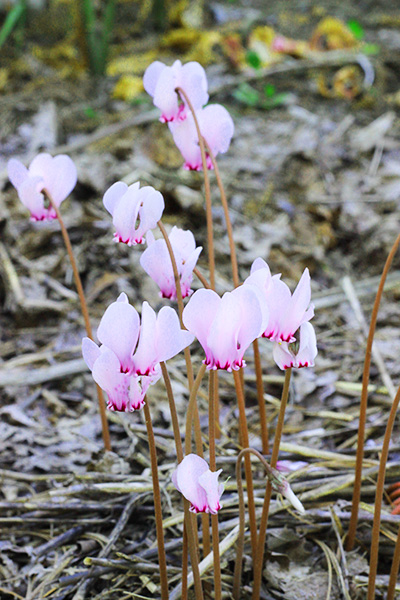To read more by topic or date, see our Newsletter Archives page.
October 7, 2023
“I cannot endure to waste anything so precious as autumnal sunshine by staying in the house. So I have spent almost all the daylight hours in the open air.”
–Nathaniel Hawthorne, 1804-1864 , American writer and novelist, Notebook , Oct 10, 1842.
It’s Shipping Season and Fall Bulbs are Going Fast!

|
We started shipping late this week and, thanks to our hard-working crew, orders have been flying out the door. Woo-hoo! We expect to ship every fall order we’ve already received in the next three weeks and orders that arrive today or later by Halloween. Don’t worry if your weather’s getting cold or there’s an early frost: bulbs can be planted until the ground freezes (mid-November here in southeast Michigan).
Please remember that we reserve bulbs on a first-come first-served basis (starting with orders placed last January) and ship to customers in colder zones first. If we have your email address, we’ll send you a tracking number when yours is on its way.
While we’ve sold out of some varieties, we had bumper crops on others and now are offering 25 varieties of daffodils, tulips and diverse bulbs at 15-20% off. See them all at our Bulbs on Sale page – and then order (or order more) for your best spring ever!
Planting Tips to Foil the Critters
It’s so disappointing: you plant your bulbs in full sun, well-drained soil, and at the recommended depth, but don’t see any flowers the next spring! What went wrong? If you dig down into the soil and find nothing, not even a rotted bulb, it’s likely that squirrels or other digging mammals ate them. Don’t give up –there are a number of things you can do as you plant them this fall to increase the odds of great blooms next spring.
First, the easiest: plant types of bulbs that animals don’t like to eat! All parts of daffodils, bulb to blossom, are toxic to squirrels and chipmunks as well as avoided by rabbits and deer. They come in many combinations of yellow, white, orange, peach, and even red highlights and there are varieties suitable for northern, southern, and coastal gardens. Better still, they’ll multiply over time – often one sign of an old homestead are the clumps of daffodils blooming in the spring.
Other bulbs that are rarely eaten include snowflakes (Leucojum), hyacinths, and many of our Fall-Planted Diverse varieties such as alliums, winter aconites, glory-of-the snow, Spanish bluebells, snowdrops, grape hyacinths, silver bells, Dutch iris, and Siberian squill. To see a complete list suitable for your climate, choose your garden zone and the Animal Resistant category in our Heirloom Bulb Search
We strongly recommend that first-time growers of crocus and small diverse bulbs cover their bulbs after planting. Freshly-dug soil can attract the interest of squirrels and chipmunks, and tulips, crocus, and lilies are especially tempting. Digging can disturb any bulbs, even if they’re not eaten, so protect your newly-planted bulb beds by covering them with
If animals burrow to your bulbs from below, you can use wire-mesh bulb cages either home-made or purchased at garden-supply shops or bury planting baskets or plastic pots covered with chicken-wire. In either case, use a mesh that will allow the stems to emerge easily in spring.
You can also deter rodents by lining your planting hole with chicken grit, crushed gravel, or crushed shale, sprinkling some on the top as well. These have sharp edges and discourage voles and squirrels from digging further.
Bitter or pungent sprays (like Liquid Fence and those containing capsaicin) work as well, though you’ll need to re-apply after a rainfall. (In the spring these can also be effective to protect tender shoots as they emerge, as rabbits seem to delight in nipping them down to soil-level.)
Our customers have also reported success by planting allium amongst their lilies and crocus: the scent of the bulbs discourages squirrels and voles in fall while the foliage does the same for rabbits in the spring. Good luck, and if you have other tried-and-true tips, please let us know!
Bulbs That March to the Beat of a Different Drum
Our Sternbergia and cyclamen have just started blooming this week, reminding us of the varieties that - though planted in the fall - don’t bloom in spring like daffodils or tulips and may arrive in active growth and benefit from being planted as soon as possible. For all of these, we recommend planting in their own section of the garden, and marking their places well, so that they won’t be hidden by other plants or have something else planted on top of them.
Purple-headed garlic (or drumstick allium) blooms in summer - July here - extending the allium season long past its spring/early-summer extravaganza. Their slender stems and leaves work their way through neighboring plants bringing their cheerful bursts of purple. They’ll naturalize over time, and - like other allium – animals tend to leave them alone.
Cyclamen may have leaves when it arrives, or may not put out any its first fall, so marking it is especially important: the first sign of it you may see are the delicate flowers emerging the following fall. Here in Michigan they tend to bloom just as the first leaves are falling, so keep an eye out for them so that they don’t get buried in leaves. Their foliage will emerge after they bloom.
Lycoris radiata, red spider lilies, put up leaves in their first fall, but resent transplanting (unless it’s from one neighbor’s yard to another) and may not bloom till their second fall. Since their foliage dies back in early summer, first-time growers are often worried that the bulbs have died, but they’re going through their normal summer dormancy. Please be patient, though they are slow to begin flowering, once established they will multiply. with more bursting through the tired remains of summer each year.
Similarly, surprise lilies (Lycoris squamigera) will send up foliage in the spring and then have a period of dormancy of 6-10 weeks followed by the “surprise” appearance of lavender-pink flowers seemingly out of nowhere, leading to their other names: magic lilies, resurrection lilies, and naked ladies. Like Lycoris radiata, they’ll return well in following years given sunshine and relatively dry summers.
Oxblood lilies (Rhodophiala) will arrive with leaves or send them up soon after planting but then won’t bloom till late summer (or even later). Your patience will be rewarded in future years: as our friend Greg Grant of Texas wrote in Country Living Gardener, oxblood lily is “easy and adaptable [and] thrives in any type of soil, with any pH, and any exposure. Moreover, it never needs dividing, never needs extra water, and has no insect pests. Its only two requirements are a dry summer and not removing its foliage before it goes dormant naturally” in late spring.
And returning once more to sternbergia, plant them upon arrival so they can get their leaves up for the fall and water them moderately. Since their foliage stays green through winter, it’s a good idea to cover them with a light, airy mulch of straw if your winters are harsh. They prefer to be kept fairly dry in the spring and early summer, and, left undisturbed, will multiply over time and bring golden accents to the early days of autumn.
You’ll find these, along with other lesser-known plants that follow a more traditional spring-blooming schedule, amongst our Diverse Fall bulbs. Why not give some a try this fall? You’ll be rewarded in years to come!
Share Our Gazette with a Friend
Please help us “Save the Bulbs!” by forwarding our newsletter to a kindred spirit, garden, museum, or group.
To Reprint Any Part of Our Gazette . . .
Simply credit www.oldhousegardens.com.













